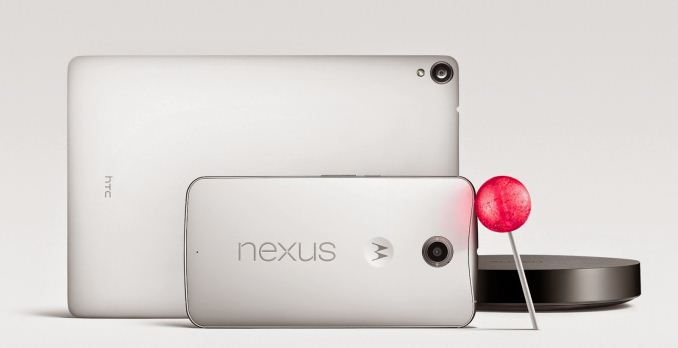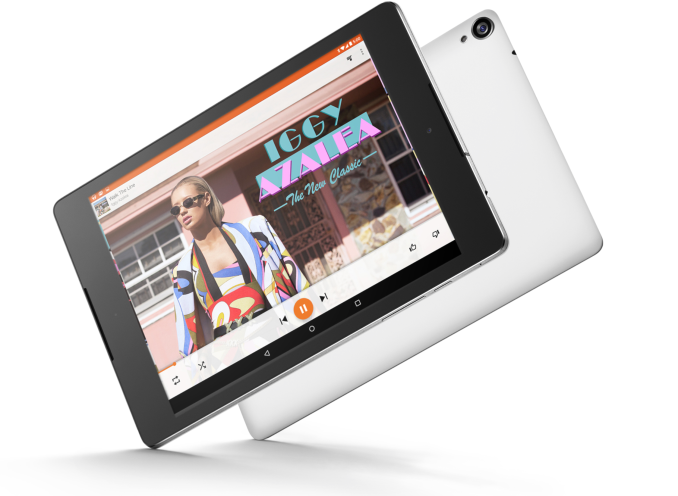Google Announces the Nexus 6 and Nexus 9 Running Android Lollipop
by Brandon Chester on October 15, 2014 12:33 PM EST
Today Google has officially announced the newest devices in the Nexus line, just one day before Apple's October event. Both devices have been rumored for some time now, and this is the first time in a while that we've seen Google introduce a new smartphone and tablet at the same time. The first device in the announcement is the Nexus 6, made by Motorola. The second is the Nexus 9 tablet made by HTC. To give an overview of how both devices look on paper, I've put together their specifications in a chart below.
| Nexus 6 | Nexus 9 | |
| SoC | 2.7GHz Snapdragon 805 (APQ8084) with 4 x Krait 450 + Adreno 420 at 600MHz | 2.3GHz 64-bit dual core Tegra K1 Denver SoC |
| RAM/NAND | 3GB LPDDR3 + 32/64GB NAND | 2GB LPDDR3 + 16/32GB NAND |
| Display | 5.96" 2560x1440 AMOLED | 8.9" 2048x1536 IPS LCD |
| Network | 2G / 3G / 4G LTE | WiFi only or 2G / 3G / 4G LTE SKU |
| Dimensions | 82.98 x 159.26 x 10.06mm, 184g | 153.68 x 228.25 x 7.95mm, 425g WiFi, 436g LTE |
| Camera | 13MP Rear Facing with F/2.0 aperture and OIS, 2MP FFC 4K video recording |
8MP Rear Facing with F/2.4 aperture, 1.6MP FFC |
| Battery | 3220 mAh (12.236 Whr) | 6700 mAh (25.46 Whr) |
| OS | Android 5.0 Lollipop | Android 5.0 Lollipop |
| Connectivity | 802.11a/b/g/n/ac + BT 4.1, USB2.0, GPS/GNSS, NFC | 802.11a/b/g/n/ac + BT 4.1, USB2.0, GPS/GNSS, NFC |
| SIM Size | NanoSIM | NanoSIM on LTE SKU |
 The Nexus 6 features a similar appearance to Motorola's other devices like the Moto X and Moto G. The plastic back is surrounded by a contoured aluminum frame that curves downward at the top where the 3.5mm headphone jack is located. On the back is Google's traditional Nexus logo, accompanied by an indented motorola logo and a centered rear-facing camera. The front is dominated by a large 5.96" display with a pixel density of 493ppi, and stereo speakers on the top and bottom bezels.
The Nexus 6 features a similar appearance to Motorola's other devices like the Moto X and Moto G. The plastic back is surrounded by a contoured aluminum frame that curves downward at the top where the 3.5mm headphone jack is located. On the back is Google's traditional Nexus logo, accompanied by an indented motorola logo and a centered rear-facing camera. The front is dominated by a large 5.96" display with a pixel density of 493ppi, and stereo speakers on the top and bottom bezels.
In terms of its specifications, the Nexus 6 is competitive with all the current Android flagship devices. It packs Qualcomm's latest silicon, a hefty battery, and a high resolution display. However, those premium specs are accompanied by a premium price of $649 outright which is significantly more than the $349 that the Nexus 5 is priced at. The Nexus 5 has been given a new web page along with the other Nexus devices which suggests it isn't going disappear with the launch of this newer, more expensive smartphone.
The next announcement was the Nexus 9 made by HTC. This is the first tablet from HTC since the days of Android Gingerbread and Honeycomb where HTC announced they were exiting the tablet market. With its soft touch back, the Nexus 9 is similar in its design to the Nexus 5. Unlike the Nexus 5 which was an entirely plastic construction, the sides of the Nexus 9 are made of brushed metal.
The front of the device is similar to the Nexus 7 with its asymmetrical bezels. The shape of the device is a departure from any tablet Google has produced before, with a 2048x1536 4:3 display like Apple's iPad. Both the 8.9" display size and 4:3 aspect ratio make the Nexus 9 a significantly larger device than the Nexus 7.
The SoC is the biggest point of interest with the Nexus 9. It will be the first device to ship with Nvidia's Project Denver architecture. This is a custom 64-bit ARMv8 architecture designed by Nvidia, a significant departure from the standard ARM cores used in previous Tegra chips. We covered the details about Tegra K1 Denver previously and you can read that over to get a more in-depth look at NVIDIA's new chip.
Along with the new device announcements comes the official name for the next version of Android. Android L is now Android 5.0 Lollipop, and it will ship on the new Nexus 6 and Nexus 9. Lollipop comes with Google's new Material Design and Google's new ART runtime, and will be rolling out to existing compatible Nexus and Google Play Edition devices in the coming weeks.
The Nexus 9 will be available for pre-order on October 17th starting at $399 for 16GB, while the Nexus 6 will be available sometime in late October at $649 for 32GB.
Source: Google Blog











148 Comments
View All Comments
danbob999 - Wednesday, October 15, 2014 - link
3:2 would have been OK for a tablet but 4:3 is just too bad for movies. You loose about half the screen with black bars.Ortanon - Wednesday, October 15, 2014 - link
4:3 isn't as good for movies as 16:10. Good job pointing out the one thing. I guess you just bought your tablet to watch movies on.mkozakewich - Wednesday, October 15, 2014 - link
Also, a 4:3 tablet would most likely lose half the screen for absolutely everything, and not just movies.(Display manufacturers have a bad track record with taking 4:3 resolutions and just chopping a bunch off to make a 16:9 ratio.)
techconc - Thursday, October 23, 2014 - link
When people use 16:9 or 16:10 on desktops, they typically don't have one large MS Office window open. They have multiple windows open and often compare documents side by side. That makes sense on the desktop, but each window isn't 16:10. Mobile devices typically use one window at at time, so the shape of the device is critical.dalingrin - Wednesday, October 15, 2014 - link
16:9 isn't great for large tablets but I don't think 4:3 is ideal either. A ~9" 3:2(like the Surface Pro 3) would have been perfect though I'm not sure that is currently available from display manufacturers.Ortanon - Wednesday, October 15, 2014 - link
For tablets, 3:2 is The One Ratio To Rule Them All.kron123456789 - Wednesday, October 15, 2014 - link
Yep, "One Ratio To Bring Them All And In The Darkness Bind Them." :)Ortanon - Wednesday, October 15, 2014 - link
lmaoSilenus - Thursday, October 16, 2014 - link
^ This ^ I'll slowly come to the conclusion that 3:2 might be the best compromise of ratio for a tablet.Impulses - Wednesday, October 15, 2014 - link
Dunno why everyone keeps saying 16:9, vast majority of Android tablets were/are 16:10 and it does make a big difference. I noticed the narrower aspect ratio the second I picked up a 16:9 Windows RT tablet...That being said, I do think 4:3 or 3:2 works better for 9"+ devices... Specially for people with smaller hands. That aspect ratio would be terrible for a 7" tablet tho, so I dunno how anyone can claim Apple OR Google was right...
Less rectangular might work better for hybrids and mid sized devices, once you get too desktop class devices (17"+) it depends entirely on desk space and number of screens, and at under 7" 16:10 & 16:9 still handle and travel better.
No one got it entirely right, but more choices are always a good thing®.